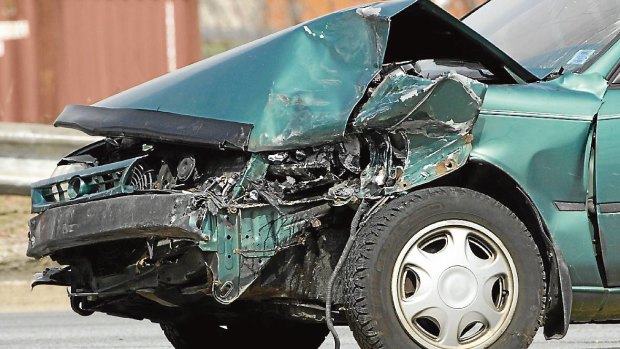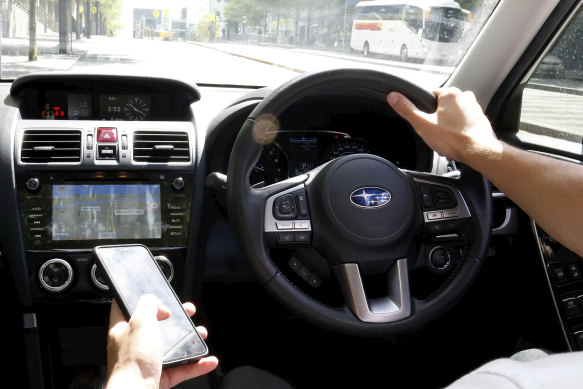Save articles for later
Add articles to your saved list and come back to them any time.
Twenty-three people die on Australia’s roads on average every week – about four a week in Victoria – in crashes so commonplace that sometimes they don’t even make the news. But the cumulative loss of life is almost unfathomable: 11,800 people killed nationwide in the past decade.
Another 39,000 or so people are hospitalised after crashes every year, around a quarter of them with life-threatening injuries, and for each victim there are many more traumatised loved ones.
Perhaps the biggest challenge in saving more lives is to bust the misconception that those deaths are inevitable.Credit: iStock
Victoria has witnessed an alarming increase in road deaths: 147 people have been killed so far this year, which is 35 more deaths than this time last year and the five-year average.
This state, along with the Commonwealth and all other states and territories, committed in 2021 to halving road deaths by 2030 and getting to zero deaths by 2050, but clearly something has gone very wrong. The Age believes it demands urgent attention.
Australia was once a world leader in road safety. It was the first country to make front and back seatbelts mandatory, starting with Victoria in 1970. There were 1061 road deaths in Victoria alone that year. We pulled that down to 242 last year, and 1194 Australia-wide. Progress has stalled, though. Deaths have been stuck at those levels for the past decade.
Perhaps the biggest challenge in saving more lives is to bust the misconception that those deaths are inevitable, and are an acceptable and necessary “toll” we pay for motor vehicle transport. There is ample evidence they are not. Norway was already a world leader in road safety and managed to reduce its road deaths by half between 2010 and 2019.
Victorians die at twice the rate of Norwegians, as measured by population (4.1 deaths versus two deaths per 100,000 people in 2019) and by how much we drive (four deaths versus two per 100 million vehicle kilometres).
Switzerland, Sweden (both 2.2 deaths per 100,000 people), the United Kingdom (2.7), Ireland (2.9) and Denmark (three) all show we can make further improvements. But we need a new approach.
Road Safety Minister Melissa Horn, speaking this month after a man was killed crossing the road in Melbourne’s inner north, said it was “behaviours that people are taking out onto roads that are causing these fatalities and these collisions”. She flagged education campaigns and police enforcement in response.
It is true that too many people do the wrong thing behind the wheel: speeding, driving while intoxicated, not wearing a seatbelt, and, increasingly, using phones. Measures to enforce better behaviour, such as the new roadside cameras catching people using phones or not wearing seatbelts, are positive steps.
But that is not the full story.
Use of phones will driving is part of the problem. Credit: Darrian Traynor
The guiding principle in road safety globally for the past 20 years has been the “Safe Systems” approach. It accepts humans are fallible, and says the road environment needs to be designed to minimise harm when they inevitably make mistakes. For Victoria, that would mean the hugely expensive task of redesigning many of our roads with divided lanes to prevent head-on collisions, as well as more roundabouts, roadside barriers, pedestrian crossings and separated bike lanes.
A Victorian parliamentary inquiry found in 2021 that 30 to 35 per cent of the state’s roads have a one-star or two-star safety rating out of five using the internationally recognised iRap system. Most are in the regions, and that is where most deaths happen. While poor maintenance exacerbates the problem, these roads were dangerous even when they were brand new.
The RACV told the inquiry that upgrading 180,000 kilometres of dangerous roads to the minimum recommended three-star standard would take 1000 years at current levels of funding.
If we can’t afford to redesign all those roads (and we can’t), the RACV said the only way to make them safe was to slow vehicles down. It called for an urgent review of speed limits on country and outer-urban roads.
A human body’s ability to tolerate kinetic energy is well understood: someone travelling in a car at 90km/h has a 20 per cent chance of surviving a head-on collision with another car; but at 70km/h that jumps to a 90 per cent chance of surviving.
A 110km/h limit is perfectly suitable on the Hume Freeway and other roads with high-standard infrastructure. But Victoria’s default speed limit of 100km/h, which is high by international standards, is plainly inappropriate for some narrow, undivided and tree-lined country roads where crashes are inevitable.
Our default urban speed limit of 50km/h is also out of step with trends in developed countries, many of which are lowering road trauma by adopting the UN’s recommendation of 30km/h speeds in built-up areas. Someone crossing the road has a 90 per cent chance of surviving if hit by a car at 30km/h, but only a 10 per cent chance at 50km/h.
Any step to reduce speed limits will prompt howls of outrage, and there needs to be a balance between safety and utility. For example, Australia’s geography presents unique challenges: we need to travel long distances to remote areas.
Everyone should ask themselves how many deaths they are willing to accept on our roads. If the answer is none, then we must be willing to consider and discuss reasonable measures that have been shown to save lives.
Patrick Elligett sends an exclusive newsletter to subscribers each week. Sign up to receive his Note from the Editor.
Most Viewed in National
From our partners
Source: Read Full Article









